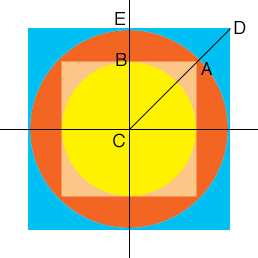| |||
| Math Central | Quandaries & Queries |
|
Question from George, a parent: A circle within a square which is inside a larger circle which is also within a square. (a circle in a square inside a circle in a square) |
Hi George,
I think the equation of the smaller circle is $x^2 + y^2 = 25.$
A circle with centre at the origin and radius $r$ has equation $x^2 + y^2 = r^2$ and thus the smaller circle has radius 5 units. Here is my diagram. $C$ is the origin.

Triangle $ABC$ is a right triangle and $|AB| = |BC| = 5.$ Use Pythagoras' theorem to find the length of $CA.$ This is the radius of the larger circle.
Can you complete the problem now?
Rather than asking for the dimensions of the larger square I would have asked for the length of its diagonal. Can you find the length of the diagonal?
Penny
 |
||
Math Central is supported by the University of Regina and The Pacific Institute for the Mathematical Sciences.